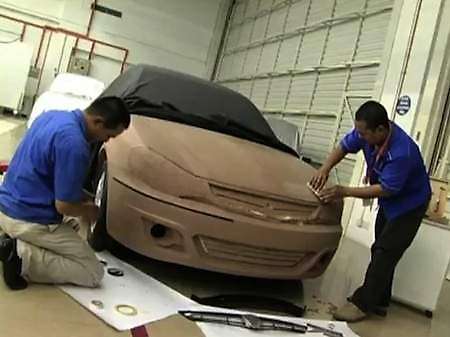
Friday, December 11, 2009
Mysterious clay model in Proton R&D video
Saturday, September 12, 2009
Upcoming Proton Saga (other name might be used) for Australia.. there is even a teaser website
This new small sized sedan will be launched in 2010 and will take on the Toyota Corolla with a long list of standard features and an improved1.6-litre 4-cylinder petrol engine. It will have a spacious 413 litre boot, seating for 5 passengers and is expected to be offered with either 4-speed automatic or 5-speed manual transmissions. The Proton Saga is 4.35 metres long and 1.68 metres wide, ensuring its ease of use in the urban environment. "Australia's lowest cost sedan will be the cornerstone of our range and Proton will present a value for money proposition from the entry level model [Savvy] to the sporty Satria. "We will launch a revitalised range with the low cost sedan at a price and specification level that will make it hard to ignore in the market," stated Startari. The new model will be the Proton Saga, a sedan-based version of a revised Savvy that Proton insists will undercut the Chinese opposition that will begin entering the marketplace. "It will be significantly different to the current Savvy, it is the same car that was launched in Malaysia recently as the Saga, it is a sedan and is powered by a 1.6-litre Campro engine in place of the 1.2-litre engine in the current Savvy," contined Mr Startari. It is not yet known whether the Saga name will be used in Australia, but Proton predicts sales of around 2000 units annually. The company will not announce the pricing or the name of the new car until the launch in 2010. Proton also has a teaser website for the upcoming sedan: http://www.newsedan.com.au/



Tuesday, September 1, 2009
New Proton Saga 1.3 Manual B-Line Solid
|
Tuesday, August 11, 2009
Proton Saga BLM price
Hi everyone,
Best Model of the Year 2009.
“It’s only been a year since the new Saga began, but it has already won the 2009 Frost & Sullivan award for the Best Model of the Year. An award that recoginizes market growth, leadership in product innovation, and continuous improvement. And because it is you who inspire us to create award-winning vehicles like the Saga, we thank you.“
- quoted from Proton.com
Model: Proton SAGA 1.3cc and 1.6cc
Transmission: Manual/Auto
| B-LINE (Solid) | B-LINE (Metallic) | M-LINE (Solid) | M-LINE (Metallic) | 1.6cc B-Line (Solid) | |||||
| Model | Manual | Auto | Manual | Auto | Manual | Auto | Manual | Auto | Manual |
| Price (OTR) | RM 36,048 | RM 39,048 | RM 36,498 | RM 39,498 | RM 38,548 | RM 41,048 | RM 38,998 | RM 41,498 | RM 39,000 |
Sunday, August 9, 2009
Anti-Protonians vs Not-so-pro Protonians...
So, my 1982 1.6 Toyota Corona have been giving me problems of late...the engine crankshaft has taken its toll, it being subjected to various forces...car bearings are bald, thanks to the lack of periodic maintenance...timing belt needed changing...well, to be honest, I have been talking about giving my buddy an overhaul...but have been postponing it due to financial constraint...and the fact that I couldn't afford to spare my car for a week long...
[Note : I just sent my car to overhaul...so now I am currently transport-less...and having my favourite Walrus to drive me around...*grin*...]
Anyhow, my dad and I have been discussing about the idea of purchasing a new car...since my maroon red buddy wasn't exactly fuel economical in anyway...plus, it was due time that I passed this 3-generation buddy on to my brother for his usage...and I, having a salary should start investing on assets such as these...(A house is next on the list, but that will have to wait for now...Banks won't approve my loan based on my current salary, that's for sure)...
Being a new graduate with a meagre salary, I didn't give much thought on Toyota and Honda cars, as they were very much out of my price range, and I would have to slog hard, just to keep up with interest alone...(Bank interest is 3.65% flat for local cars...I am not so sure about foreign cars now...)...
So I had no choice but to toy with local made cars such as Proton and Perodua, which was more affordable...there wasn't much...a 1000cc Kenari/Viva, 1.3cc Myvi/Saga and a 1.6cc Persona...all ranging from RM41k-55k...
After all these years of being away from my family, and being financially independant...one would have taught that I would be strong enough to sort out and make big decisions...this car hunting season showed the other part of me...
I did have my eye on a 1.3 Proton Saga which was the cheapest of the car listed...No, I am not at all a Proton fan...nor am I for 'Support Local Made Goods' campaign...Proton as a company suffered badly throughout all these years, thanks to bad management and corruption...but, I...being a first time purchasee, wasn't looking for anything show-off-ish, nor sporty...YET...just something reasonably priced...and most importantly, with boot space...
My parents weren't too keen on the idea of me purchasing a Proton car...they think that the quality may not suffice, and I will have loads of problem with customer services...and car maintenance in near future...yeah, we blardy anti-Protonians...but if I were to scrap out the idea of buying Proton cars, I am stuck with Perodua Viva or Myvi...which both comes WITHOUT much boot space...
Why am I so particular about boot space, you may ask...just in case you didn't know...my Toyota Corona 1.6 is a large and conservative rectangular box...a comfortable saloon car of the 1980s...it holds a little more than 504litres in boot space alone...and that is where I have been keeping boxes of music books, my violin...and spare clothes to change...yea, there was a time when I literally lived in that car...
Plus the fact that I am used to driving a big car with large space...hence, Perodua Viva (the smallest car of the lot) was definitely out of the picture...I had considered Perodua MyVi (should I have chosen it, it would have been deep blue in colour)...but it was such a common car...common not in the design...but the fact that almost EVERYONE owns a MyVi...I look outside my window...and chances are...I will see a MyVi pass by me, every 5 seconds...and that has been giving me nightmares of late...
So, I went to check out the Proton Saga 1.3 that has been launched a few years back...and I could not have been more disappointed...the design of the interior of the car, looked so cheap...and plastic...that I discarded this choice completely...I even refused to give it a test-drive...the allocated space was fine...bearable in at least...but all those thinsy whimpsy buttons looked like they came from a toy keyboard or something!!...so that was that...Proton Saga...scrapped off my list...
Proton Persona was next...while it wasn't the greatest design available...but it had sufficient boot space, and I didn't mind taking it out for a test drive...it was slightly cheaper than the Perodua MyVi...and since I was not crazy of those two options...I thought I'd might as well look for something that I could get my money's worth...besides, Persona had a 1.6cc engine, whereas MyVi had a 1.3cc...I gave it a test drive...performance was rather sluggish, for a 1.6cc engine with an auto gear box...especially when I was testing the highest class of the Personas...maybe the manual transmission would give a better performance...Well, that...I will never know...as Protons do not allow test driving for manual cars...
So, Proton Persona was my best bet...now, came the tough task...convincing my anti-Protonian parents to allow me to purchase a Proton...and to get my dad to become my guarantor...that latter task was pretty simple...it was the first one, that is gigantic...
Wasn't looking forward to that confrontation, though...I don't like unpleasant situations especially within my family...and while I know that my parents are more than willing to listen to my two cents worth...the idea of not agreeing with them give me knots in my stomach...it depresses me...have you ever felt that before??...I feel like a kid once more...wanting to gain my parents' approval...
Anyway, to date...the situation has been solved...but not the way I thought it would be...*grin*...
But that will have to wait...need to catch up on my ZZZZzzzz first...Part II coming up!!...
Friday, August 7, 2009
An Early Arrival and New Lower cost Models to Spearhead Revitalised Proton Line-Up
The new low-cost sedan was originally slated for early 2010 but will now be brought to market four months early as part of a cost efficiency onslaught from the Malaysian car maker.
The new car, based on the Malaysian Saga sedan, will have an all new name for the Australian market and will join low cost variants across all Proton passenger car models with new specifications and ultra competitive pricing, as the company continues to restructure its Australian operations.
Proton's value-leading sedan will come to market with a sub-$13,000 price tag and will spearhead a range boasting extreme value for money.
It will be launched initially with Proton's 1.6 litre Campro engine and five speed manual as standard with an automatic and a smaller engine option to be available from February 2010.
Proton will add to its Satria Neo, Gen2 and Persona models with lower cost entry level models featuring new specifications in an effort to attract more buyers to the company's value for money proposition.
The new lower cost Proton models will be introduced during November 2009 and will position Proton as an economy leader in the new car market which, along with its focus on rebuilding and refreshing its dealer network, will equip it for strong growth in 2010.
Proton is continuing its recruitment of high calibre dealers to broaden the reach and service levels for customers after it severed ties with almost half its existing dealers earlier this year.
Managing director of Proton Cars Australia John Startari says a combination of new specifications, improved manufacturing efficiencies and a stronger Australian dollar has allowed the company to formulate a lower pricing structure across its model range.
"Along with our new price leading sedan, economy car buyers will be able to take advantage of Proton's trademark Lotus engineered handling as well as our acknowledged reliability along with lower prices right across the range," said John Startari.
"Our plan is to champion the value proposition without sacrificing safety, quality and reliability and that has been particularly attractive to the new dealers who we have been recruiting," he said.
"Clearly there will be new low cost brands entering the market in the coming months, however Proton's strength is that it has been in this market for close to 15 years and is a factory owned operation with the full backing of our parent company in Malaysia. Product, pricing and marketing support have received major boosts from our parent company to ensure that we have the tools to expand our market share in this country.
"With a lower cost sporty Satria Neo, Gen2 and Persona as well as the entry level sedan, Proton will have a very structured range of cars with more variants covering the market from sub $13,000 to a shade over $20,000."
Mr Startari reiterated the message that Proton is here to stay and has a solid base on which to build its future expansion.
"Proton has already recruited a number of new dealers and they have told us that they had considered taking on other low cost brands but did not want to take the risk with brands that do not have an established record in Australia," he added.
"There are more than 25,000 Protons on Australian roads and we believe we can now take the brand to a higher level," Mr Startari concluded.
Proton was established in 1983, and is Malaysia's largest manufacturer of automobiles. With operations in key markets including the UK, Western Europe, the Middle East and across South-East Asia and Australasia, Proton produces a range of cars from versatile and reliable four-door family sedans to sporty three-door hatchbacks and utilities, and is also the parent company of world-renowned sports car maker, Lotus.
The Proton brand is accelerating its learning curve through technology transfer with strategic partnerships and technical collaborations.
Proton's promise is to be a marque which builds cars with passion and soul which are a delight to drive and a pleasure to own.
Tuesday, August 4, 2009
Proton Saga EV Concept
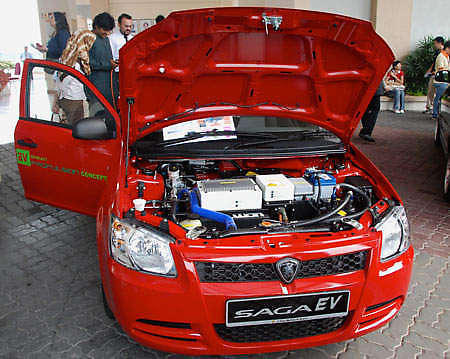
Proton previewed an all-electric version of the Proton Saga sedan in University Putra Malaysia, Serdang during the “Proton Exora - The Making” seminar organized by SAE International earlier this week. The “Proton” name would definitely make sense on this particular car! ![]()
You might expect this plug-in electric vehicle to have been co-developed with Detroit Electric which have a deal to produce electric cars based on the Proton GEN2 and the Proton Persona for certain overseas markets under the Detroit Electric brand. But on the contrary, what you see above is an in-house project done with the help of unnamed suppliers and partners.
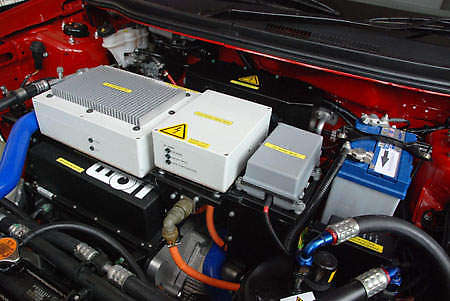
This means that unlike the Detroit Electric e46 (based on the Proton Gen 2) and the Detroit Electric e63 (based on the Proton Persona), the electric Saga (officially called the Proton Saga EV Green Propulsion Concept for now) is probably being considered for the local market, although the auto maker is very tight-lipped about possible launch dates. It could take years.
The emissions-free Proton Saga EV on display features a 125kW (168hp) brushless DC electric motor, mated to a 5 speed manual transmission. It has a 20kWh Lithium Ion Polymer battery pack (12 separate batteries stored in the trunk). Because of the batteries, truckspace is pretty much non-existent but this is quite normal with concept electric cars based on a chassis that was originally designed to take a regular combustion engine and fuel tank. A production car would ideally have neater integration of the batteries.
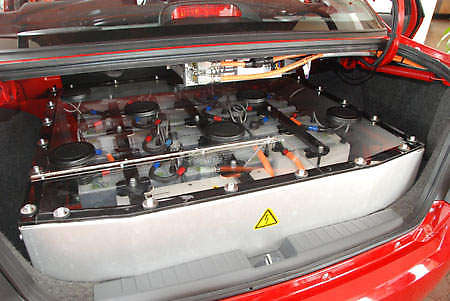
According to Proton, the Saga EV can sprint from 0 to 100 km/h in 10.1 seconds, up to a top speed of 161 km/h, with a driving range of 109 kilometers over a full charge. Both the Detroit Electric e46 and e63 will feature a 150kW Axial Magnetic Flux motor instead.
There is more! The “green-mobil” also features re-generative braking and an electric power steering, apart from a built-in Batter Management System (BCMU), a plug-in charger (with a household power outlet), air conditioning as well as an In-Vehicle display screen that displays various information pertaining to the electric vehicle functions. Sources also revealed that Proton has plans to built an electric Exora MPV, and, is currently working on some hybrid vehicles as well, for research and development.
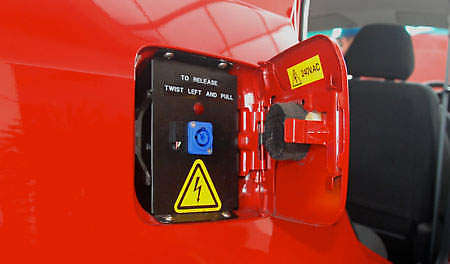
Since Proton took the trouble to produce a fully functioning Saga EV Concept, I am sure it is a matter of time till we actually see Proton-built electric cars on the road, but it doesn’t end at just producing such emissions-free vehicles. There has to an infrastructure ready to accommodate charging in the outdoors, which is something that will involve the government, apart from the private sector.
Monday, August 3, 2009
Proton Company Vector Logo
Proton is the Malaysian national automobile manufacturer which was established in 1983 under the direction of the former Prime Minister, Dr. Mahathir Mohamad. Proton Holdings Berhad, the holding company, is listed on the Bursa Malaysia. The name Proton was derived from the Malay acronym for PeRusahaan OTOmobil Nasional, or ‘National Automobile Enterprise’.
Based on technology and parts from Mitsubishi Motors, production of the first model, the Proton Saga began in September 1985 at its first manufacturing plant in Shah Alam, Selangor. Initially the components of the car were entirely manufactured by Mitsubishi but slowly local parts were being used as technologies were transferred and skills were gained. The 100,000th Proton Saga was produced in January 1989.
Sunday, August 2, 2009
Proton unveils Saga SE and Exora MT models
LABIS: Proton Holdings Bhd yesterday launched the Proton Saga SE (special edition) and Proton Exora MT (manual transmission) here yesterday.
Prime Minister Datuk Seri Najib Tun Razak unveiled the new variant models and the Felda-sponsored Proton Satria Neo S2000 rally car after launching the Felda Settlers Day celebrations at Felda Maokil.
Proton chairman Datuk Mohd Nadzmi Mohd Salleh in a statement said the Saga SE, a premium and sporty variant to the existing model, was targeted at youngsters who want to be different.
The car comes in either brilliant red or solid white with a black finished roof top, new front grille, sporty front, rear and side skirting, as well as new alloy rim design.
The Saga SE also boasts a new interior finishing complete with leather seats, door trims, a leather wrapped steering wheel, pearl white meter panel finishing and a CD player with MP3 capability.
The Saga SE is estimated to be sold at RM43,000 and RM45,500 for the manual and automatic variants respectively.
Meanwhile, the Exora MT will be priced at RM64,998 and RM64,548 for the metallic and solid variants respectively.
Proton managing director Datuk Syed Zainal Abidin Syed Mohamed Tahir said bookings were open for both models at RM500 for the Saga SE and RM1,000 for the Exora MT.
The Felda-sponsored Satria Neo S2000 rally car, which was constructed to conform to the latest FIA (Federation Internationale de l’Automobile) specifications, has raised the performance bar for the rapidly expanding FIA Super 2000 rally series.
Construction of the car was the result of collaboration between Proton and Mem (Mellors Elliott Motorsport) in the development and production of a World Super 2000 rally car to meet all technical specifications set by the FIA.
Thursday, July 30, 2009
proton saga's engine

Hybrid Campro engine
In March 2007, Proton and Lotus have announced their concept model of a Proton Gen-2 powered by a hybrid powerplant that uses the Campro engine. The concept model was revealed during the 2007 Geneva Motor Show from 8 ~ 18 March 2007
The hybrid powerplant system, which is known as EVE system (Efficient, Viable, Environmental) will be using the same S4PH engine as the one that powers the present gasoline version of the Gen-2, combined together with a 30 kW, 144V electric motor. The main purpose of the hybrid powerplant system is to provide a hybrid system that can be retrofitted to existing models, retaining the same powerplant and also eliminates the need to develop a completely different platform, like the Honda Civic Hybrid. Unlike the IMA (Integrated Motor Assist) technology in the Civic Hybrid which uses a bulky Ni-MH battery pack, the EVE Hybrid system will use a Li-ion battery pack inside the engine bay.
The EVE Hybrid System will have 3 key technologies:-
“Micro-hybrid” start-stop system - An integrated starter-alternator system is installed to switch off the engine automatically when the engine stops, for example at the traffic light. The engine will automatically restart when the gas pedal is depressed.
Full parallel hybrid technology - Combines the existing S4PH engine with a 30 kW, 144V electric motor, resulting in higher power (141 bhp combined), higher torque (233 N-m combined), lower emission (up to 22% carbon dioxide reduction) and better fuel economy (up to 4.6 L/100 km[13]). The system also includes regenerative braking system.
Continuously Variable Transmission (CVT) - The CVT system provides an infinite number of gear ratios for better efficiency.
The combined power and torque for the powerplant system are as follows:-
Max power (gasoline engine only): 110 bhp (82 kW/112 PS) @ 6,000 rpm
Max torque (gasoline engine only): 148 N·m (109 ft·lbf) @ 4,000 rpm
Max power (combined): 141 bhp (105 kW/143 PS) @ 5,500 rpm
Max torque (combined): 233 N·m (172 ft·lbf) @ 1,500 rpm (limited to 180 N-m continuous)
Proton will start commercializing their upcoming hybrid vehicles equipped with the EVE Hybrid System within 2010-2011
CAMPRO ENGINE SPECIFICATION BY PROTON
Developed in partnership with Lotus Engineering, this engine grants PROTON complete vehicle design independence. Its breakthrough engine technology produces low fuel consumption, yet gives rapid, high power response, and can even be produced to run on alternative fuels.
Major design objectives :
- Space-saving transverse east-west direction engine installation
- Designed for long life of at least 10 years or 250,000 km
- Best performance in class
- Flexibility to use future technology (CPS & NGV)
- 80% recyclable to meet 2005 requirements
- comply to future exhaust emission legislation requirement
Saga BLM
This is the new PROTON SAGA BLM. It looks very much like a MERCEDEZ C-CLASS from behind. This is a good head up for PROTON. I am sure this will be the main attracting factor for people to purchase PROTON SAGA BLM BARU. But the interior is very dissappointingly bad. It looks very cheap although the audio CD radio set is from CLARION. But to drive away a MERCEDEZ BENZ C-CLASS for RM35k is certainly a good bargain, don’t you think? It’s due to be launched in the next few days.

THE TAIL LIGHTS ARE VERY SIMILAR TO MERCEDEZ BENZ C-CLASS

MERCEDEZ BENZ C-CLASS..SEE THE RESEMBLANCE!



BAHAGIAN DALAM PROTON SAGA BLM BARU

Wednesday, July 29, 2009
Facts you need to know about kereta saga
The Proton Saga is the first car produced by Malaysian auto manufacturer Proton. Originally based on the 1983 Mitsubishi Lancer Fiore, the Saga first debuted in September 1985 and retained its core Fiore design for two decades, before a successor designed in-house by Proton was launched to replace the ageing platform in 2008.
Since 1985, the Proton Saga and its variants contribute to most of Proton's sales and revenues. The Saga is also the longest surviving model produced by Proton, soldiering on for nearly 22 years.
First generation
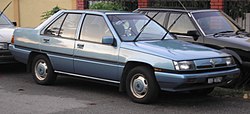 | |
| Manufacturer | Proton |
|---|---|
| Also called | Proton MPI (United Kingdom) |
| Production | 1985–2008 |
| Predecessor | none |
| Successor | Proton Wira |
| Class | Compact |
| Body style(s) | 4-door saloon 5-door hatchback |
| Layout | FF layout |
| Engine(s) | 1.3 L 4G13 I4 1.5 L 4G15 I4 |
| Curb weight | 940 kg (2,072 lb) |
| Related | 1983 third generation Mitsubishi Lancer |
Saga (1985–1991)
The Proton Saga was launched in September 1985 by Malaysia's then Prime Minister, Mahathir bin Mohamad. Before the production of Proton Saga, a contest was held to choose the name of the first national car, and the name Saga was chosen from the winner of the contest, Ismail Jaafar,[1], a retired military soldier. When asked why he chose this particular name, he replied as "saga" (Abrus precatorius) is a type of soft, fragile but productive seed commonly found in Malaysia, and that the Proton Saga 1.3 litre engine "is as strong as the saga seed".
The first Proton Saga that rolled off the production line was presented to the Malaysian National Museum as a symbol of the beginning of the Malaysian automotive industry. Tun Dr. Mahathir also drove a new Proton Saga with a flag across the Penang Bridge during the opening ceremony of the bridge on 14 September 1985.
Early Saga models were powered by SOHC 8-valve 4-cylinder petrol engines sourced from Mitsubishi, available in both 1.3- and 1.5-litre displacements. Both engines were available with a 5-speed manual transmission, but a 3-speed Mitsubishi Tri-matic automatic was available with the 1.5-liter engine in 1987.
The Saga was originally offered as a 4-door saloon, followed by the addition of a hatchback variant, introduced in 1988 as the Proton Knight and was later know as Saga Aeroback. The Proton Knight was designed for the European market as the hatchback was more popular in United Kingdom.
In 1989, Proton sold the Saga in the United Kingdom with the slogan Japanese Technology, Malaysian Style. Since then, United Kingdom contributes most of Proton's export sales. The Saga name was not used and it was simply known as the Proton 1.3 or 1.5. The UK models reverted to the dashboard used in the Mitsubishi Lancer, complete with HVAC controls not found in the domestic model.
In 1990, the line-up was revised with the introduction of 12-valve Megavalve engines, which increased power ratings to 75 bhp (56 kW) (from the original 70.5 bhp (53 kW) in the former 8-valve (Magma) version[2]) for the 1.3-litre engine, and 90 bhp (67 kW) for the 1.5-litre engine. On domestic models, the Saga also gained the "Megavalve" moniker. Minor exterior modifications included a new grill and wraparound black trim pieces. In addition, rear seat belts and a third brake light were fitted as standard.
Saga Iswara (1992–2008)
In 1992, the Saga was given a facelift and its name expanded as Proton Saga Iswara (also known in short as Proton Iswara), after a species of butterfly in Sarawak. Modifications included slimmer headlights, plastic bumpers, side mouldings, coloured door handles, grooved taillight clusters and rear number plate repositioned to the bumper. This particular model is used as taxis in Malaysia and some are converted to NGV. Due to the modification, boot space was reduced by half to accommodate the NGV tank and there are only a few petrol stations by Malaysian oil-giant Petronas in the Klang Valley that sell natural gas, although there are plans underway to increase the number of stations selling it at various locations around Kuala Lumpur.
Models exported to Singapore and the United Kingdom were available with multi-point fuel injection and catalytic converters to meet Euro I emissions standards. This model was known as the Proton MPi in the United Kingdom. The introduction of the Proton Persona in 1993 replaced the corresponding models in the Saga range in the United Kingdom and this continued until the entire range was replaced in 1996.
In 2001, to regain sales and be competitive with Perodua, Proton introduced a special edition of Saga Iswara Sport based on the Aeroback version which included a new bodykit, metallic rear wing, jewel-effect headlights and Altezza lights, among other changes. It was only available in silver, with a manual transmission and a 1.3-litre engine. The original Saga Iswara Aeroback was still available in a 1.5-litre engine.
While the Iswara Aeroback underwent further modifications in the domestic market to become the Saga LMST in 2003, the saloon variant remained on sale unchanged.
| Since the 1990s, the saloon variant of the Proton Saga Iswara dominated as the preferable car model for taxicabs in Malaysia, as seen with these examples in Kuala Lumpur. |
Saga (2003–2008)
As a loose successor to the Saga Iswara Sport, Proton gave the Iswara a new facelift and renamed it back to Saga (or know as Saga LMST by local car community) in 2003. The interior has an entirely new dashboard, door panels and an instrument panel with a digital display consisting of an odometer, a fuel gauge and a temperature gauge. Meanwhile, the exterior received new headlights and taillights and colour-coded bumpers and wing mirrors. Proton retuned the 1.3-litre carburettor engine, and fitted a new exhaust system, increasing its power rating to 83 bhp (62 kW). It is only available with the 5-speed manual transmission.
On March 5, 2007, Proton launched the 50th Merdeka Anniversary Promotion in Malaysia, where the announced new price of the Proton Saga at that time was RM26,999. Advertising campaigns for the Saga Aeroback used a notable rendition of Justin Timberlake's hit single SexyBack, with the lyrics changed to "AeroBack". The promotion was made as a support to Malaysia's 50th Merdeka Day and also to thank Proton's customers for their support since Proton Saga was first launched,[3] receiving several minor cosmetic changes. The move was also an attempt by Proton to steal potential sales from Perodua's then-forthcoming budget supermini, the Viva. That year, the Proton Saga became the second best selling car behind Perodua MyVi and the best selling saloon car in Malaysia, with over 15,000 orders.
Second generation (2008–present)
 | |
| Parent company | Proton |
|---|---|
| Also called | Proton Base Line Model (BLM) |
| Production | January 2008[4]-present |
| Class | Subcompact |
| Body style(s) | 4-door saloon |
| Engine(s) | 1.3 L Campro I4 1.6 L Campro I4 |
| Transmission(s) | Aichi Kikai 5-speed manual, Mitsubishi 4-speed automatic[5] |
| Wheelbase | 2,465 mm (97.0 in) |
| Length | 4,257 mm (167.6 in) |
| Width | 1,680 mm (66.1 in) |
| Height | 1,502 mm (59.1 in) |
| Curb weight | 1,060 kg (2,337 lb)-1,085 kg (2,392 lb) |
| Fuel capacity | 40 L (11 US gal; 9 imp gal) |
| Related | Proton Savvy |
On January 18, 2008, Proton unveiled the successor to the 2007 Saga, which was planned to be phased out in June 2008. Retaining the Saga name, the new car is an indigenous design, essentially based on a stretched Proton Savvy platform. The new model is an in-house design developed in collaboration with Korea's LG CNS and Lotus Engineering. This model enables the Malaysian company play to its strength in the home market i.e. the three-box sedan. The Proton Saga is not planned for U.S. launch but will be sold throughout Southeast Asia, in China, India and Australia
As of February 2008, approximately 23,000 customer bookings had been made for the car since its launch and the corresponding waiting time for delivery during that same period stretched up to 5 months.[6]
Specifications
The Saga comes in 3 different specifications with the choice of manual or auto transmissions starting from the base specced N model to the fully kitted M model. Aichi Kikai supplies the 5-speed manual while Mitsubishi the 4-speed automatic. The basic N model retails from RM31,500 to the RM39,800 high specced M model. The new Saga would be the cheapest Proton once the RM26,999 original is retired. Proton dubs the new Saga as "The People's Car".
Engine and performance
The new Saga is powered by the same 1.3-litre Campro engine (which was co-designed with Lotus) that is fitted to entry-level Gen-2s. Besides the 1.3L engine option, the 1.6-liter version is also available as an exclusive engine option for taxi operators[7] before being offered to regular customers.[8] Like other Proton models powered by Proton's own Campro engines, the 1.3-liter engine is rated at 94 hp (70 kW; 95 PS) at 6,000 rpm and 120 N·m (89 lb·ft) at 4,000 rpm, while the 1.6-liter version (not including the Campro CPS engine which is not being used in the Saga) produces 110 hp (82 kW; 110 PS) at 6,500 rpm and 148 N·m (109 lb·ft) at 4,000 rpm. Both engines feature the new Integrated Air-Fuel Module (IAFM) which varies the airflow into the engine to improve efficiency, smoothening out the problematic dip in the torque curve in the lower and middle rev ranges. Its output matches that of a 1.3-litre in the Satria Neo. Power delivery characteristics in both cars are remarkably different. The torque could be felt after 2,500 rpm and all the way to 4,000 rpm. The car feels peppy to drive and acceleration to highway speeds is good. The 5-speed manual from Aichi Kikai is not geared towards the ultimate refinement at cruising speeds, but it does offer a good spread of torque everywhere, not to mention good overtaking power anywhere from 80-120 km/h. Suspension setup consists of MacPherson struts and a stabilizer bar up front with a torsion beam in the rear. Its Lotus designed torsion beam suspension enables it to turn in sharply, hold its stance well through corners, understeering to a sizeable extent. Fuel economy is very good, ranging from approximately 6 L/100 km (47 mpg-imp; 39 mpg-US) for the manual transmission to 6.2 L/100 km (46 mpg-imp; 38 mpg-US) .[9] for the auto and is considerably less when traveling at 80 km/h (50 mph) in fifth. Top speed is around 160 km/h (99 mph) and 0-100 km/h time is about 16 seconds. The electrical system has also been updated with coil-on-plugs instead of the traditional ignition cable system, eliminating power loss.
Cabin and interior
It has boot space of (413 l (14.6 cu ft)). [5] Because the new Saga, like its predecessor, is expected to be standard among Malaysian taxicab operators,[7] the car is designed to accommodate a compressed natural gas tank without considerably restricting boot space. There is ample room for 5 adults and the interior is bigger than the old Saga. Top-of-the-line version have a set of 14-inch tyres and ventilated disk brakes for added traction, providing the car with strong braking force and better road holding. Airbag is also fitted to the medium-specced models onward.
Awards
Since the official launch of the second generation Proton Saga in January 2008, the car has won 3 major automobile awards. Autocar Asean, the Malaysian edition of the longest running car magazine in history has awarded the new Saga "Winner of the Small Sedan/ Hatchback Category" for 2008. Shortly after that, the car was voted as the "Best People's Car" at the Asian Auto - VCA Auto Industry Award 2008[10]. In November the same year, the new Saga won yet another major Malaysian automobile accolade when it was declared the "Winner of the Entry Level Car Category" under the New Straits Times/ Maybank Car of the Year Awards for 2008.[11]
Sponsor Links
Cheap Cars For You?
Find Used BMWs Cheap
Best Deal Ever
www.car-auction.com
Run Your Car On Water!
See To Believe
Use Your Money For Something Else!
www.hybridwaterpower.com
No Fuel Needed For Car!
No Need To Go To Gas Station Anymore
Need To See To Believe!
www.gas4free.com








